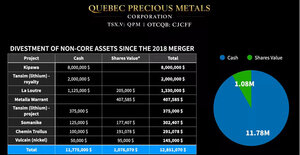The Life Sciences Report: John, I believe you have 14 stocks under coverage, and only half of these are rated Buy. Is there some systemic or market consideration keeping you neutral or negative on half of your coverage? I would say that in the U.S., it would be unusual to see a biotech analyst with only half of his/her coverage rated Buy.
John Hester: Not all the stocks in my coverage are biotechs. That's a key point. The Australian market is obviously much smaller than the U.S. market, so naturally there are fewer high-quality companies to cover than in the U.S. As analysts, we need to be a little more diverse in coverage than the typical biotech analyst in a U.S. brokerage house would be. Some of the stocks I cover here in Australia are health insurers, and others are hospital operators, but all have some sort of a healthcare focus. Also, it's not unusual here to have a spread of Buys, Sells and Holds in the coverage list.
If I'm going to cover a biotech stock, I have to be convinced that it has potential. We certainly will not continue to hold or cover a biotech stock if we don't believe it has the potential to succeed with either commercializing a technology or with a partnering deal. On that subsection of coverage in biotechnology, we are certainly very focused on trying to pick the winners.
TLSR: You follow biotech companies with very complex technology platforms, but you originally studied economics and got your postgraduate degree in applied finance, banking and securities law. How did you become a healthcare—and more specifically, a biotech—analyst?
JH: The initial part of my career was working for Deloitte, a large public accounting firm. After a 10-year career there, I worked for Primary Health Care Ltd. (PRY:ASX). That was really transitional to becoming a healthcare analyst. I gained my introduction to the Australian healthcare sector at Primary, which has gone on to become a very large company on the Australian Stock Exchange: In fact, it's a Top 100 stock.
"Immuno-oncology continues to evolve at a very rapid pace, and that's pretty exciting to be involved in."
My next move was into the brokering industry, where I leveraged the experience that I had gained at Primary to write equities research. My career evolved and further specialized into looking, in part, at biotech stocks. Here at Bell Potter, we primarily focus on small- and midcap stocks in the healthcare sector.
TLSR: You are clearly not averse to moving out of your comfort zone into something more challenging.
JH: That's absolutely right. My philosophy is that if we don't explore new avenues, then things are going to be the same. Not all explorations are successes but, certainly, biotechnology is an area that is highly topical, particularly in the field of oncology. Immuno-oncology, in particular, is an area of interest for me, and I have been on a very steep learning curve on that industry over the last five years. It continues to evolve at a very rapid pace, and that's pretty exciting to be involved in. We are always challenged to find the next transaction.
TLSR: Looking at your coverage, valuations range from AU$20 million (AU$20M) to about AU$4 billion, micro-cap to mid-cap. Some of the names in your coverage are large enough that institutional investors can own them. Do you get a lot of calls from mutual funds and hedge funds in the U.S.? What are they looking for? For instance, are they looking to uncover undiscovered stocks, so to speak?
JH: Bell Potter has a large client base, but not so much in the U.S. We do have some clients on the West Coast of the U.S., however. We also have a large client base in Asia out of our Hong Kong office, as well as in the United Kingdom.
I think there is a very large gap between the valuations ascribed to biotechnology stocks in the U.S versus Australia. It's not uncommon to have multiples or valuations on preclinical drugs or drugs that are early-stage in the clinic that are well ahead of valuations that we see on the Australian Stock Exchange. A lot of the incoming calls I've taken are from Asian-based hedge fund managers who are, as you say, looking for undiscovered value.
Viralytics Ltd. (VLA:ASX) is a good example of that. The company has a market capitalization of about AU$136M today. It has one drug candidate, Cavatak (CVA21; a purified preparation of coxsackievirus A21), in Phase 2 clinical trials. The company recently reported promising results from a Phase 2 monotherapy trial that showed high levels of efficacy in late-stage unresectable melanoma patients. The CALM study achieved a durable response rate of 21.1% (from 54 patients) compared to 16.3% achieved by T-VEC (talimogene laherparepvec) from Amgen Inc. (AMGN:NASDAQ) in its recent Phase 3 randomized clinical study. Back in late April, the FDA's oncologic drug advisory committee voted 22–1 in favor of T-VEC approval in advanced melanoma; T-VEC's Prescription Drug User Fee Act (PDUFA) date is Oct. 27, 2015. If approved, T-VEC would be the first oncolytic virus to come to the U.S. market. Yet Viralytics, with Cavatak in Phase 2, has only an AU$136M market valuation from investors.
I would suggest that if Viralytics were listed in the U.S., the valuation the market might ascribe to it would be multiples of its current valuation in Australia. It's a good example of the gap in value ascribed by a local market as compared to offshore markets. For that reason, there are some UK-based and some U.S.-based specialist fund managers on the register. In fact, together they own a combined 45% of the company. These investors are looking for the gems that are struggling for airtime on the local market.
TLSR: Let's stay with Viralytics. I would note that Viralytics has more than doubled its share price over the past 52 weeks. But there is a difference between the competing drugs. Unlike Viralytics' Cavatak, Amgen's T-VEC is genetically engineered.
JH: That's correct. But T-VEC and Cavatak have similar efficacy profiles based on the Phase 2 data that we've seen from Viralytics.
Cavatak preferentially binds to the receptor protein ICAM-1, which is typically expressed by tumor cells. The virus replicates within the cell, causing it to lyse (rupture) and release progeny virus. Replicated viruses repeat the process in nearby tumor cells. The lytic process releases tumor cell debris that may elicit a response by the patient's immune system against the tumor, providing a secondary but important immunotherapeutic effect.
In the CALM study, responses have been observed in injected lesions, non-injected, non-visceral legions and in distant non-injected visceral legions. Also, preliminary results of analysis of the tumor microenvironment showed that CVA21 induced immune cell infiltrates and expression of PD-L1, and this is a particularly exciting development. For this reason we expect Viralytics to pursue an approval for CVA21 as combination therapy for use with checkpoint inhibitors.
"There is a very large gap between the valuations ascribed to biotechnology stocks in the U.S versus Australia."
Having said that, there are a number of important differences between CVA21 and T-VEC. One important distinction is that Cavatak is suitable for intravenous administration and intratumoral injection, versus T-VEC, which is an intralesional injection.
Cavatak is now being studied in four separate trials. The first is the Phase 2 CALM extension trial in melanoma. The second is the Phase 1/2 STORM trial in visceral cancers using intravenous administration of the drug. Targeted cancers include non-small cell lung cancer, castrate-resistant prostate cancer, melanoma and bladder cancer. STORM is being conducted in the UK. Both trials are ongoing, and we are keenly anticipating the outcomes. The company discussed the very early-stage results from these two trials in mid-June at the ninth International Conference on Oncolytic Virus Therapeutics in Boston, and there were early signs of efficacy in some of those indications as well. We feel that if the STORM study is able to demonstrate upregulation in immune system activity and reduction in tumor size, it could be a significant value-creating event.
The third trial is a Phase 1 in combination with ipilimumab for late-stage melanoma, and this is currently recruiting. The fourth is also a Phase 1 study in superficial bladder cancer.
TLSR: You seem to be making a strong point that Cavatak could be used as an intravenous infusion versus the intralesional or intratumoral administration of T-VEC.
JH: The potential to treat visceral tumors by intravenous injection could represent a very significant uplift in valuation for the company. But that's not the only thing. T-VEC is a genetically modified virus, whereas Cavatak is not. Depending on how you look at it, I think the risk with genetically modified viruses is that at some point they may revert to the wild-type virus—and that's not a good thing—whereas Cavatak, since it's not genetically modified, doesn't have that risk of reversion. Cavatak has these two advantages: its ability to be intravenously administered, and not being genetically modified.
TLSR: What about the safety profile of Cavatak?
JH: So far, the results have shown no serious adverse associated with the use of Cavatak. There have been grade 1 and 2 adverse events, so they were quite mild. T-VEC also has a favorable side-effect profile, albeit there were some grade 3 adverse events in its Phase 3 monotherapy trial.
The vast majority of patients in the CALM study had been heavily pretreated, some with numerous rounds of chemotherapy, and hence their immune systems were suppressed. As Cavatak has a relatively benign side-effect profile, it may be particularly suited to these patients who are unable to tolerate further chemo or have developed resistance.
TLSR: What clinical milestones should investors look for right now? Particularly, what market-moving catalysts are ahead for Viralytics?
JH: The biggest one over the next year or so is going to be the efficacy results from the STORM trial. It's a dual-arm study. The first arm is with Cavatak as a monotherapy across a range of tumors. I'm looking for efficacy results from that trial. As I said previously, I think that any upregulation in immune system activity might well be an indicator that drugs like PD-L1-blocking antibody pembrolizumab (Keytruda; Merck & Co. Inc. [MRK:NYSE]) or other PD-1 or PD-L1 inhibitor therapies, might have better efficacy following an initial dose of Cavatak. I think that would be a very significant value driver for Viralytics.
TLSR: There are only 33 patients in this Phase 1/2 STORM trial, spread out among all the different indications—non-small cell lung cancer, castrate-resistant prostate cancer, melanoma and bladder cancer. Do you believe data can be generated from this trial that can actually move this stock?
JH: I take your point on the small patient numbers. But this study is looking for signs of efficacy from intravenous dosing. If Viralytics gets those signs, it will inevitably lead to a larger Phase 2 study. The potential for a combination with some of these other therapies—PD-1 or PD-L1 inhibitors—is significantly enhanced if there is upregulation in immune system activity. We're looking for that to be the major value driver over the short term.
TLSR: What's your target price on Viralytics?
JH: Currently, we have a target price for Viralytics of $0.96/share. It closed recently at $0.74/share. It has, as you say, more than doubled in the last 12 months, and it's had a good run in the last month alone. There are other firms in the U.S., ROTH Capital Partners out of Boston being one, with significantly higher valuations on the stock. I will continue to monitor the progress of these trials and adjust my target price as the data come to hand. However, at this time, we have not baked in further uplift in value. We'll wait for ongoing data before changing our assumptions.
TLSR: It's interesting that with this big run, I'm not seeing any profit-taking. Why do you think people have tended to hold this stock?
JH: I was not able to attend the recent American Society of Clinical Oncology (ASCO) conference, but in my analysis of the companies that presented, my view of Viralytics was reinforced. I think that the investor base genuinely regards the company as grossly undervalued relative to comparable stocks in the U.S., even though the immuno-oncology space is very crowded right now, and even though this is a one-trick-pony company. I think that is why you're seeing a lot of investors in there for the long term. I expect that, over the course of the next one to two years, we are likely to see a liquidity event. That may be someone coming on to buy the company and/or investing in further trials. Viralytics is my No. 1 pick in the sector, and it's one I'm perhaps most excited about.
TLSR: Would you go ahead to the next name, please?
JH: Sirtex Medical Ltd. (SRX:ASX) has an interesting technology. It's a medical device company as opposed to a drug company. Its SIR-Spheres (yttrium-90 microspheres) administer selective internal radiation therapy for inoperable liver cancers. It's a targeted delivery of radiation to the tumor. These microspheres, or beads, are covered with a radioactive material and injected via the hepatic artery into the liver.
This company had an oral presentation at the recent ASCO conference in which it presented results from its Phase 3 SIRFLOX study in metastatic colorectal cancer. There were two key points to come out of this Phase 3 trial, which included more than 530 patients. The first is that the treatment arm of the trial did not produce a systemic benefit. In other words, there was no extension or increase in progression-free survival (PFS) across the intent-to-treat population. That was the primary endpoint, which the trial failed.
"It's not unusual in Australia to have a spread of Buys, Sells and Holds in the coverage list."
A secondary endpoint of the trial was liver PFS, where the trial did achieve statistical significance. In the control arm of the trial, the standard therapy achieved median liver PFS of 12.6 months. In the active, or experimental, arm of the study, which combined SIR-Spheres with chemotherapy (FOLFOX [oxaliplatin + leucovorin + 5-fluorouracil]), plus/minus the monocolonal antibody bevacizumab (Avastin; Genentech/ Roche Holding AG [RHHBY:OTCQX]; allowed at the discretion of the treating investigator), it achieved liver-only PFS for a median 20.5 months. That was a near eight-month extension in PFS, which was fairly significant. The stock declined by approximately 50% on the day that Sirtex announced the trial had not met its primary endpoint, before recovering a significant amount of value when results on the secondary endpoint were better understood.
TLSR: At this point, with the failure of the study to achieve its primary endpoint, what is the value proposition or growth theory for Sirtex?
JH: We are looking pretty carefully at this company right now. It had revenues of approximately AU$130M in 2014 from just 8,561 dose sales globally. This is relative to the company's estimate of up to 410,000 patients annually who may potentially be eligible for SIR-Spheres (at first-line; i.e. not suitable for surgical resection). We're looking to see what the reaction might be over the next couple of quarters to the news on the secondary endpoint. It's obvious the overall PFS was a disappointment. However, over the next couple of quarters, we're looking to see whether oncologists will continue to use the therapy because of its ability to control the disease in the liver alone. The company, as you might expect, is fairly optimistic based on the liver-only PFS results.
There's not a lot of research on the topic of liver-only PFS, but the National Comprehensive Cancer Network guidelines tell us that liver failure is a major cause of death in metastatic colorectal cancer patients. In other words the disease, in many cases, spreads first to the liver, and it's liver failure that ultimately causes these patients to succumb. By achieving a statistically significant eight-month extension in liver-only PFS, the company is hopeful for an overall survival benefit. But we won't get that data until 2017.
In the meantime, the company will continue to market the product in the U.S. and globally based on those liver-only PFS statistics. I'm not convinced that the liver-only data will be sufficient to convince oncologists that they should be using SIR-Spheres, for the key reasons that there is no systemic benefit and no data on overall survival benefit. It's really only a localized therapy. I'm keenly anticipating the reaction from oncologists over the next couple of quarters, to see whether they may continue to use this product.
TLSR: Are you saying this product is probably going to be used only as salvage therapy?
JH: In the U.S. today, it is used as salvage therapy—as a last-line therapy. It's likely there is a lot of off-label use, although the company is very careful not to promote off-label use for obvious reasons. The SIRFLOX trial was a large, randomized study in first-line therapy in patients with unresectable liver tumors. The company obviously wants to elevate the therapy from salvage to either first- or second-line therapy, but I'm not convinced that these results, as we understand them today, will achieve that goal.
TLSR: What is your rating on Sirtex, John?
JH: I have it Hold-rated at the moment. The next major catalyst for this stock will be the September quarter result, when the impact of the data from the SIRFLOX study will have been in the market for the entire period.
TLSR: Thank you, John. It has been a pleasure.
John Hester is a senior healthcare equities analyst at Bell Potter Securities. He is based in Sydney, Australia, and specializes in small and mid-cap healthcare, biotechnology and industrial stocks. Bell Potter is a leading Australian broker servicing institutional, high net worth and retail clients. Previously, Hester worked at LINWAR Securities and Select Equities, where he led the firms' coverage of the listed healthcare sector and diversified financials. Hester's experience in the healthcare sector is drawn from many years' experience at Primary Health Care Ltd., where he gained firsthand experience in the operation of general practice, imaging and pathology from one of Australia's leading healthcare organizations. His network of contacts includes executives at the highest levels within numerous companies, fund managers, commercial banks and investment bankers. More recently, he has extended his expertise to certain biotechnology stocks and has considerable industry knowledge in the field of oncology and emerging therapies therein.
Want to read more Life Sciences Report interviews like this? Sign up for our free e-newsletter, and you'll learn when new articles have been published. To see recent interviews with industry analysts and commentators, visit our Streetwise Interviews page.
DISCLOSURE:
1) Dr. George S. Mack conducted this interview for Streetwise Reports LLC, publisher of The Gold Report, The Energy Report and The Life Sciences Report, and provides services to Streetwise Reports as an independent contractor. He owns, or his family owns, shares of the following companies mentioned in this interview: None.
2) The following companies mentioned in the interview are sponsors of Streetwise Reports: None. The companies mentioned in this interview were not involved in any aspect of the interview preparation or post-interview editing so the expert could speak independently about the sector. Streetwise Reports does not accept stock in exchange for its services.
3) John Hester: I own, or my family owns, shares of the following companies mentioned in this interview: None. I personally am, or my family is, paid by the following companies mentioned in this interview: None. My company has a financial relationship with the following companies mentioned in this interview: Viralytics Ltd. Bell Potter was the lead manager in the company's March 2014 capital raise and received fees for that service. I was not paid by Streetwise Reports for participating in this interview. Comments and opinions expressed are my own comments and opinions. I determined and had final say over which companies would be included in the interview based on my research, understanding of the sector and interview theme. I had the opportunity to review the interview for accuracy as of the date of the interview and am responsible for the content of the interview.
4) Interviews are edited for clarity. Streetwise Reports does not make editorial comments or change experts' statements without their consent.
5) The interview does not constitute investment advice. Each reader is encouraged to consult with his or her individual financial professional and any action a reader takes as a result of information presented here is his or her own responsibility. By opening this page, each reader accepts and agrees to Streetwise Reports' terms of use and full legal disclaimer.
From time to time, Streetwise Reports LLC and its directors, officers, employees or members of their families, as well as persons interviewed for articles and interviews on the site, may have a long or short position in securities mentioned. Directors, officers, employees or members of their families are prohibited from making purchases and/or sales of those securities in the open market or otherwise during the up-to-four-week interval from the time of the interview until after it publishes.







































